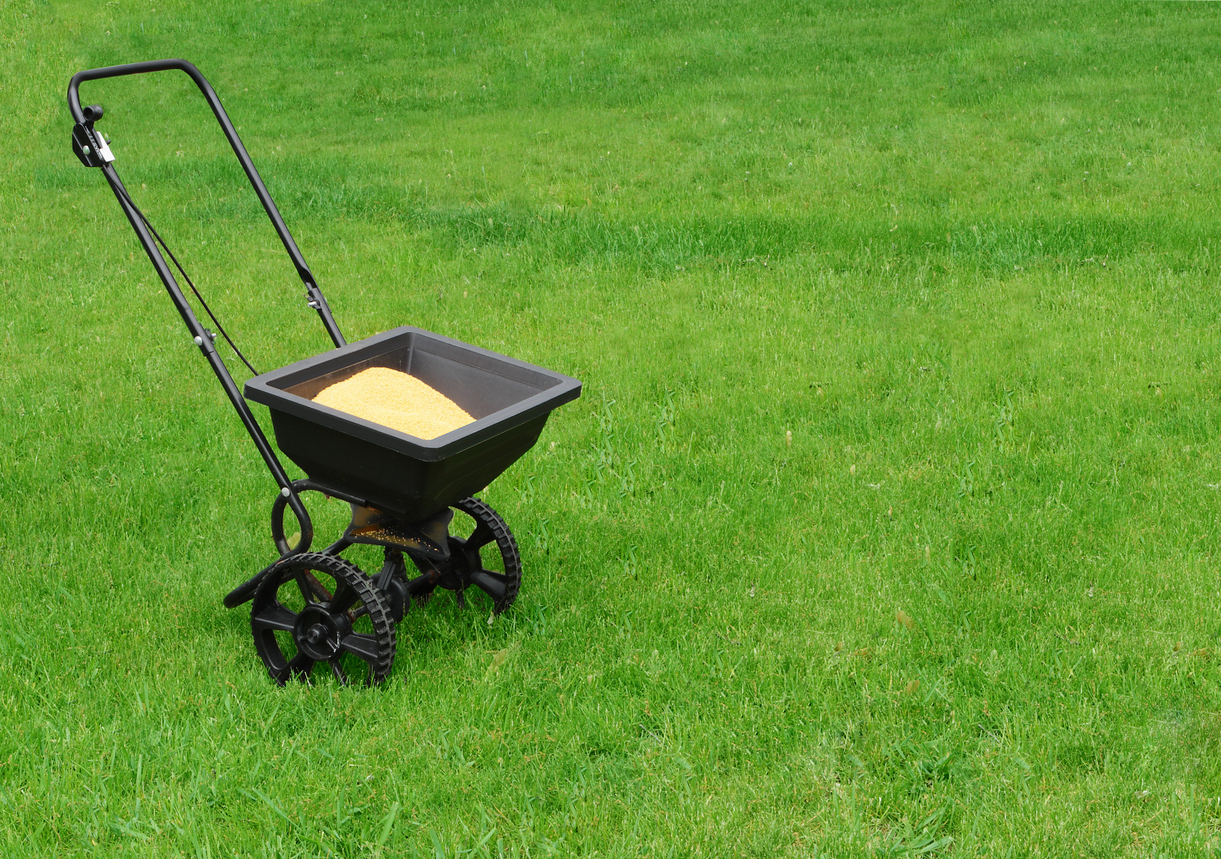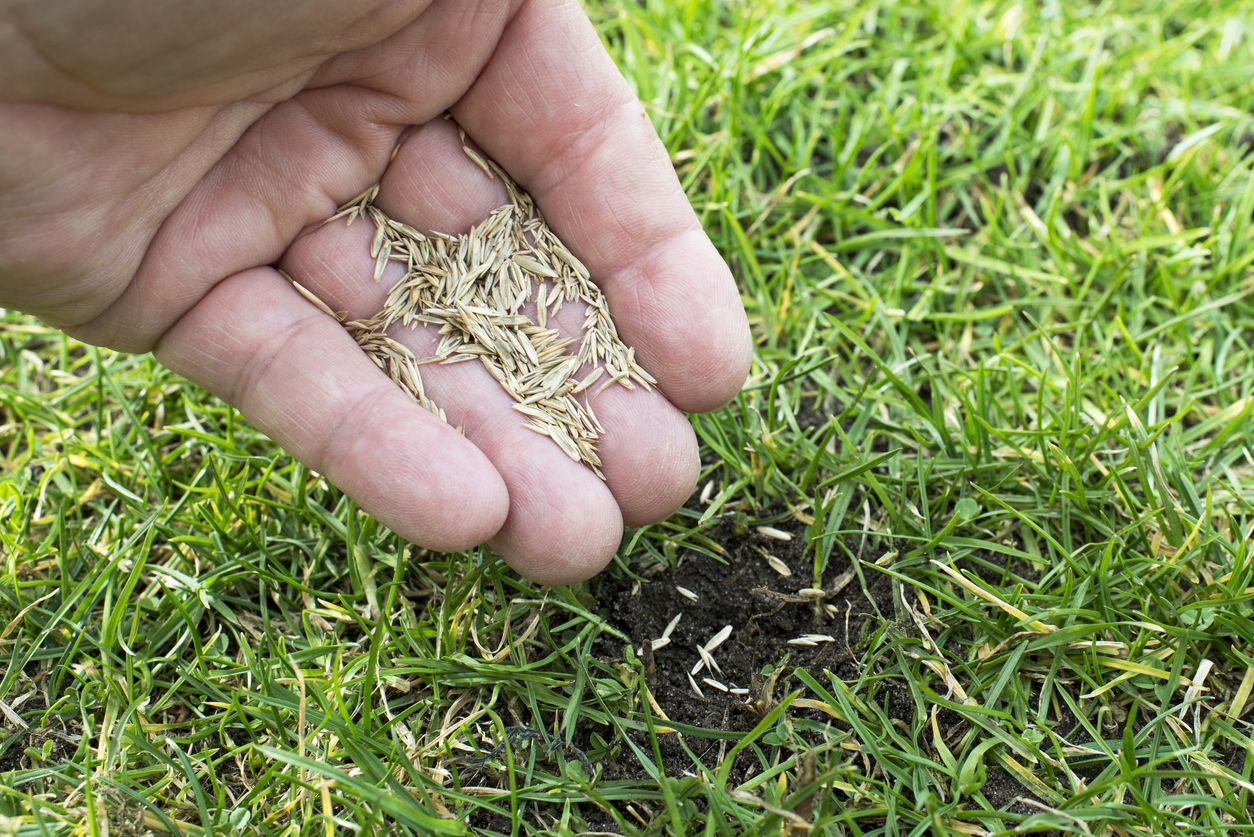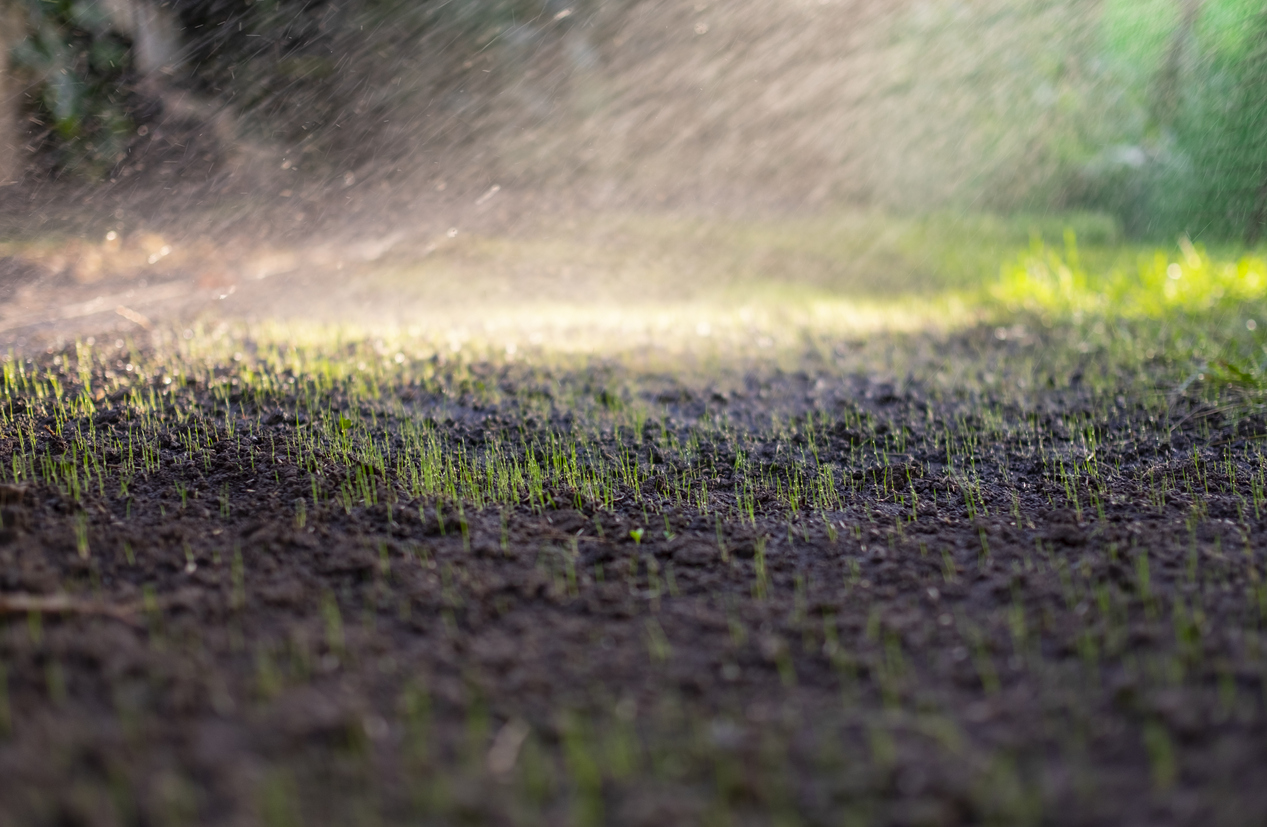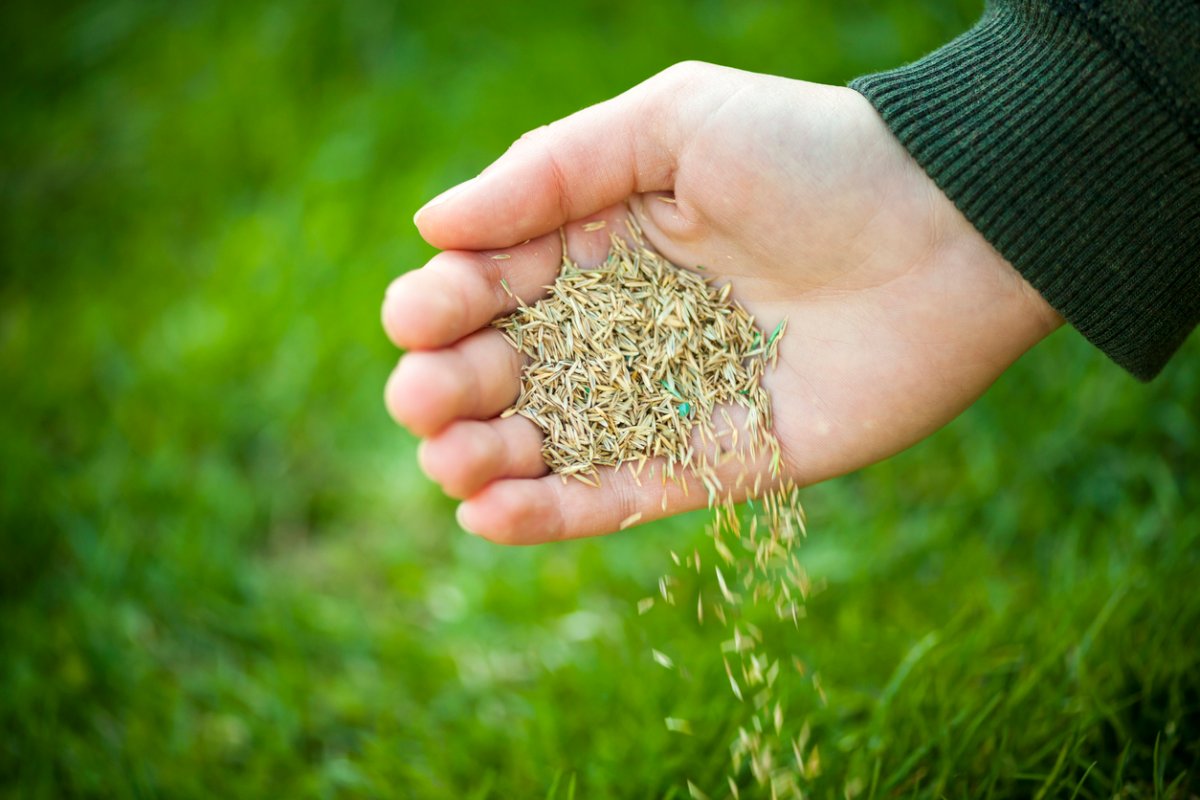We may earn revenue from the products available on this page and participate in affiliate programs. Learn More ›
Sowing grass seed, whether for scattered patches of lawn or an entire yard, is not difficult, but it takes a little research up front to ensure that you plant your grass seed at the right time. Typically, for a summer lawn with warm-season grasses, spring is the best time to plant. For cool-season grasses, opt for fall sowing, if you can.
These are general guidelines, however. “Forecast temperature is often more critical than a strict calendar date for seeding success,” says John Kaminski, Ph.D., professor of turfgrass management at The Pennsylvania State University in University Park, Pennsylvania. Other factors like grass type, soil preparation, and seed care can also affect germination. Read on to learn more about when to plant grass seed and what steps you can take to ensure success.
Why Timing Matters When Planting Grass Seed

Grass is generally broken into two categories: cool-season and warm-season varieties, depending on when the grass thrives. Each category has different sowing and maintenance requirements.
- Warm-season grasses, such as Bahia grass, Bermuda grass, centipede, and St. Augustine, thrive in climates with mild winters and hot summers.
- Cool-season grasses, such as bluegrass and ryegrass, fare best in places where summers are temperate and winter days dip below freezing. These varieties lie dormant in warmer summer months and do most of their growing in autumn and spring.
- In the region that falls between the cool-season and warm-season zones (this is known as the transition zone), cool-season grasses (sown in late summer/early fall) are more likely to flourish than warm-weather varieties. But you can choose to plant a mix of both, sowing cool-weather grass in late fall and warm-weather varieties during the spring and summer months.
If you’re not sure which grass seed best suits your area, consider your neighborhood’s altitude and USDA Plant Hardiness Zone. University extension programs can be great sources of expert advice on local grass types and can help you determine when is the best time to plant grass seed.
When is the best time to plant grass seed?

The best time to plant grass seed is when temperatures and other weather conditions are optimal for the germination and growth of your chosen grass. For example, sowing warm-season seed too soon, when temperatures are still too low, could lead to slow (or no) seed germination. Similarly, sowing a cool-season grass in the heat of summer can result in slow germination and damage to young growth.
Plant cool-season grasses in the fall.
“Cool-season grasses thrive when planted in early fall,” says Kaminski. The fall timing offers cool temperatures (between 50 and 65 degrees Fahrenheit) and natural rainfall to support seed germination and growth before winter begins. “Spring is also a good time, but fall planting allows cool-season grasses to establish before summer stresses,” Kaminski adds.
Plant warm-season grasses in the spring.
“For warm-season grasses, the best time to plant is late spring through early summer,” says Kaminski. These grass seeds need soil that has warmed sufficiently, usually to 65 degrees Fahrenheit or higher. He says these temperatures are “ideal for warm-season grass seed germination and root development.”
How long does it take for grass seed to grow?
In general, cool-season grasses grow faster than warm-season ones. Time from planting to picnicking on a new lawn can vary, though, depending on the specific seed type (some grow faster than others), site prep, seed quality (and age), and unpredictable factors like weather.
Most cool-season grass seeds should begin to germinate in 5 to 7 days. Popular warm-season grass seeds usually take 2 to 3 weeks. Be patient. Factors such as soil health and pH can affect germination and how fast grass grows, especially in new lawns. “Ignoring soil testing and amendments based on its needs can lead to poor seed establishment,” says Kaminski. Factors that impact germination include:
- Preparation, such as loosening soil, leveling, and removing rocks and weeds.
- Unseasonal dips or peaks in temperature, even in the evening, that can affect soil temperature and seed germination.
- Lack of sunlight; seeds can germinate in cloudy weather or shady spots, but seedlings need some sun (6 hours a day or more) to help them grow and spread to form turf.
- Irrigation, especially too little, affects time to germination. Seeds need steady moisture to sprout.
What to Consider Before Planting Grass Seed

Once you’ve selected a grass variety that will grow well in your region, make sure you’ve dealt with the following considerations before you sow your grass seed.
Is the soil prepared?
“One significant mistake homeowners make is neglecting soil preparation,” says Kaminski. He suggests the following steps to prepare the soil surface for seeding success:
- Clear the area of weeds and debris.
- Conduct a soil test to determine pH and nutrient needs. Adjust pH according to grass type preference.
- Till the soil to a depth of 4 to 6 inches to loosen and aerate, which promotes root penetration.
- Add soil amendments as recommended by the soil test results.
- Level and lightly compact the soil to provide a firm seedbed.
What’s the weather like?
“Monitoring soil temperature and weather forecasts can provide a more accurate planting window than relying solely on the calendar,” says Kaminski. Establish the ballpark timing and then pinpoint the best day to plant grass seed based on the forecast. Look out for an unusual cold snap, heat wave, or significant wind and rain events.
While a good soaking can help seeds germinate, a downpour can cause seeds to erode or migrate. It is best to plant grass seed before a steady rain, not right before or after a heavy one. If possible, avoid seeding the lawn on a windy day, which can affect broadcasting of seeds.
Have you applied herbicides recently?
If you use chemical treatments in your landscape to control weeds, wait at least a month after treatment before you lay down new grass seed. The recommended waiting period is even longer, usually around 4 months, after using a product to get rid of crabgrass.
Schedule your lawn treatments carefully and plan well in advance to make sure you can accommodate the appropriate waiting period after treatment and still be able to sow the seed while temperatures are ideal for germination.
Do you have a watering plan in place?

“Maintaining consistent moisture is crucial for seed germination,” says Kaminski. He advises that you “water lightly and frequently until germination, then gradually reduce frequency to encourage deeper root growth.” Overwatering can cause seed runoff or fungal diseases, and underwatering can stop seed germination. “A good rule of thumb is to keep the top inch of soil moist,” Kaminski says.
Final Thoughts
If you choose a variety of grass seed that thrives in your region, properly prepare the soil, and sow the seed when the temperature’s right, you can achieve excellent coverage with a newly seeded lawn. Once the seeds germinate, the seedlings are tender as they grow above and below the ground, establishing roots. Take care not to walk on them too soon.
FAQs
Native grasses might sprout in some areas, but there is a difference between sporadic sprouting and a broad area of seeds taking root. Just throwing seeds out will likely lead to uneven coverage. Plus, without adequate site preparation, the blades that might pop up will not be healthy, well-rooted grass. If you want to speed up the process, try asking a lawn care professional to hydroseed your lawn.
Once you spread the grass seed, use a rake to work it into soil, but only to about ¼ inch. Don’t push the seed down too deeply or cover it with a thick layer of mulch that will block light. If you can, use a roller to pass over the area after raking to ensure that seeds have good contact with soil. You can sprinkle a light layer of compost or straw over the soil to help retain moisture, but keep the layer thin enough to avoid blocking sunlight.
It’s not necessary to soak grass seed before planting; the seeds are small and typically germinate 1 to 2 weeks after planting with consistent watering. If you have a short window for the best time to seed a lawn, especially if you’re trying to get cool-season grass going before cold sets in, you can soak the seeds in water for 24 hours. Then, drain the water completely from the cup or bucket, and leave the seed in a warm location like a heated shed for a few days until small sprouts appear.
Young grass seedlings are tender. You should avoid walking on the new lawn area for at least 4 weeks. Any activities can disturb your carefully broadcast seeds, so be sure to keep kids and dogs off the growing lawn.
Avoid mowing until the grass seedlings reach at least 3½ inches high. The longer you can wait, the better.

